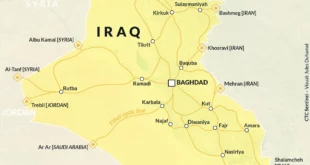CAMP ADDER, Iraq — The US soldiers call themselves the Four Horsemen as they barrel down roads with nicknames like “The Widowmaker,” staying alert through the night on a mix of caffeine and adrenaline, hoping to find roadside bombs before the bombs find them.
“There’s always some out there. There’s a threat every night,” said Sgt. Brian Parker, 36, part of a four-Humvee convoy escort team based at Camp Adder, about 200 miles (320 kilometres) southwest of Baghdad.
Guarding convoys remains one of the most dangerous assignments in Iraq despite billions of dollars spent armouring Humvees and developing equipment to detect and evade bombs. Insurgents constantly use new ways to hit the troops on their long supply routes, and the soldiers struggle to keep pace with the changing threat.
In keeping with their biblical Four Horsemen of the Apocalypse theme, the soldiers’ Humvees are named War, Death, Famine and Pestilence. “You mean I’m riding with Death?” asked a truck driver they were protecting.
On any given night, the 1st Brigade Combat Team, 34th Infantry Division, which includes the Four Horsemen, has more than a dozen convoys on the road. By the time they leave Iraq, the brigade will have logged two million miles and encountered an untold number of bombs.
So far, the brigade has lost five soldiers from roadside bombs while guarding convoys.
The US military has aggressively pursued ways to minimise the use of road convoys. It flies in supplies whenever possible. Some bases have begun purifying their own water so it doesn’t have to be delivered. But the sheer amount of supplies needed, especially weighty items such as fuel, mean convoys are still needed and remain a primary target of the insurgents.
“Much of the insurgent activity in the country is aimed at trying to impede the flow of supplies to US forces, and there are no easy solutions to the tactics they employ,” said Loren Thompson, a defence analyst with the Arlington, Virginia-based Lexington Institute. To improve their odds against the roadside bombs, often called by the military “improvised explosive devices,” or IEDs, the unit has bulldozed brush and debris away from roadsides where the insurgency is strong.
They also have spent millions of dollars in development projects in areas near the convoy routes. The idea is that if people feel they’re benefiting from the troops, they won’t work for the insurgents and they’ll be more likely to turn in people who are.
The Four Horsemen also constantly share information with other units who’ve been out on the road, to compare IED experiences and learn what new tactics are being used. “While war has always been a cat and mouse game of action-counteraction, the IED fight epitomises it,” said Col. David Elicerio, commander of the 1/34 Brigade Combat Team. “They rapidly develop new techniques. If proven successful, they spread that knowledge as far and as fast as possible,” he said. “We do the same.” The unit doesn’t make public the numbers of IEDs it has found before detonation or the number that exploded, but says the trend shows success. The brigade says that since it arrived in Iraq in April, the number of IEDs spiked in May and June, but then fell in July and again in August.
They’ve also increased the percentage of IEDs discovered before detonation from 10 per cent in May to 37 per cent in August.
But the troops remind themselves every day that the danger can’t be eliminated.
One of the soldiers killed, Brent William Koch, 22, who died June 16, was from the same platoon as the Four Horsemen. Although he rode with another team, Koch was in their platoon and trained with them for six months before deploying to Iraq. On the backs of each of their four Humvees, the Horsemen painted a picture of a motorcycle — after Koch’s love of bikes — that incorporates his initials. “It’s a sign that Brent is always covering our six, even from above,” said Day, using the military jargon for watching out for danger from behind.
Road obstacles aren’t limited to bombs, or always dangerous. They begin with the humorous interruption of stubborn camels crossing the road, and then climb up an ever-more-dangerous scale that includes spikes on the road, kids throwing rocks, small-arms fire, and rocket-propelled grenades.
The explosions, such as the one that flattened a tyre on one of the fuel trucks they were protecting during a recent mission, don’t shock the soldiers any more.
“I actually had a fuel tanker blow up right in front of us. An IED on the side of the road, it hit the truck, and we had to drive through a wall of fire to get to the other side,” said Sgt. Jason Slinden, 23. “Nothing else has been quite as big as that.” Since taking over the convoy mission in May, almost every member of the team has earned a combat action badge, testifying that they’ve come under enemy fire or been in the vicinity of a bomb going off.
Preparation for each mission includes good-natured teasing and joke-telling. Many said they think about what can happen during a mission, but once the drive begins they put it out of their minds.
“Do I think about death? Do I think about Koch?” said the team’s leader, Sgt. 1st Class Joseph Hjelmstad, 37, while rolling through the desert of southern Iraq. “Yeah.
But you got to get yourself back out there.”Â
 Eurasia Press & News
Eurasia Press & News


